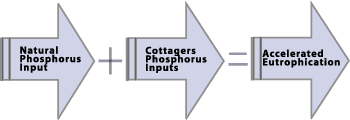Eutrophication
All lakes undergo eutrophication. It is a normal process, often referred to as the 'aging of a lake'. Over the duration of tens of thousand of years a crystal clear deep lake will eventually be transformed into a murky shallow bog filled with plant matter, possessing very low oxygen concentrations that will only support highly specialized organisms.
The catalyst for the eutrophication process is phosphorus. The annual phosphorus input to the lake provides the necessary nutrients for aquatic plant growth. Each year these aquatic plants reach the end of their annual life cycle and sink to the bottom of the lake where their decomposition depletes the water of oxygen. The phosphorus contained within this plant matter is stored in the sediment on the bottom of the lake.
The phosphorus continues to be stored in the sediment year after year until the lake enters into a 'mid life crisis' so to speak. In this stage, the lake loses its ability to store the annual phosphorus input due to a severe depletion in the oxygen at the bottom of the lake. The absence of oxygen at the bottom triggers the re-suspension of the stored phosphorus and when this available phosphorus is combined with the annual phosphorus input to the lake, the production of aquatic plant growth increases significantly.
The lake now enters into a transition phase - from 'mid life' to 'old age'. The plant matter continues to accumulate on the bottom, the oxygen depletion eventually extends throughout the entire water column and the phosphorus is continually recycled. The lake now begins to resemble a swamp and eventually will cease to exist and become land. The eutrophication process occurs so slowly that we are unable to visibly detect the changes over the course of our lifetime.
The Accelerated Eutrophication Process
In contrast to the natural aging process - the accelerated eutrophication of a lake occurs as a direct result of the input of phosphorus from sources above and beyond the naturally occurring sources.
In essence - the lake is forced into a state of 'premature aging' because of the excessive phosphorus inputs. We begin to be able to visibly observe:
A noticeable decrease in the transparency of the water.
Excessive weed growth and algae.
A decrease in fish species that require high levels of oxygen (e.g. trout) and an increase in fish species that can survive in low oxygen environments.
Accelerated Eutrophication - You & Your Cottage
In most instances the primary source of phosphorus that tips the scale in favor of accelerated eutrophication on most lakes are waterfront cottagers. Other artificial sources - such as agricultural activity bordering on a lake and industrial or commercial installations have the potential to be a major factor - but in their absence:
Waterfront cottages are the number 1 source of artificial phosphorus to cottage country lakes & consequently the primary cause of accelerated eutrophication.
Each waterfront cottage is capable of inputting between approximately 535 and 3345 grams (perhaps more) of phosphorus to the lake environment per cottage season depending on the following critical factors:
Use of household products that contain phosphorus
If your cottage (like most) has a typical septic tank and drainage field configuration, between 70% and 90% of all phosphorus entering your septic system eventually ends up in the lake. This traditional method of treating waste water was primarily designed to prevent outbreaks of water borne disease (such as cholera and typhoid). The system is not designed to be an effective method of removing phosphorus from waste water. The drainage field eventually becomes saturated with phosphorus and looses its capacity to retain the phosphorus. The phosphorus then works its way into the lake.
Use of yard products that contain phosphorus and removal of native trees & shrubs
Commercially available fertilizer used to stimulate growth of lawns, vegetable and flower gardens contain a lot of phosphorus. After application, the fertilizer lies on the surface until the first rainfall. The surface run-off generated by the rainfall carries the soluble phosphorus into the lake. The greater the surface area that is fertilized and slope of the terrain - the more phosphorus that is deposited into the lake. Compounding this problem is the removal of native shoreline vegetation. Small trees and shrubs slow down the speed of surface runoff after a rainfall and absorb some of the phosphorus making its way to the lake.
By making modest changes in your habits and behaviour at the lake - you can make a significant reduction in the amount of phosphorus your cottage inputs into the lake.

